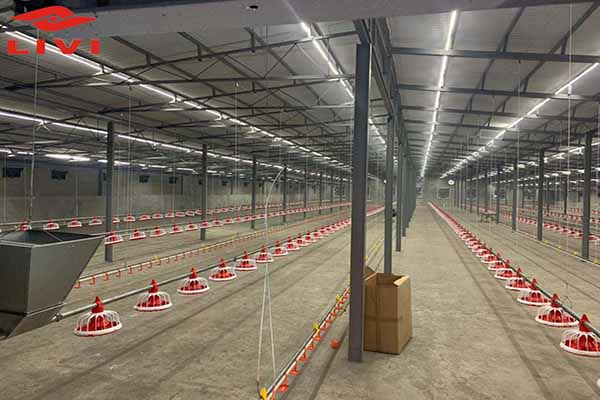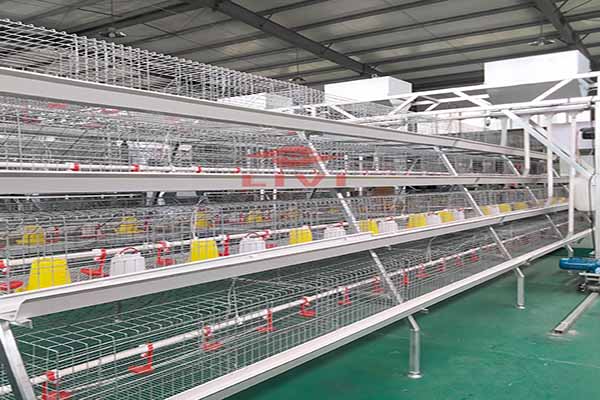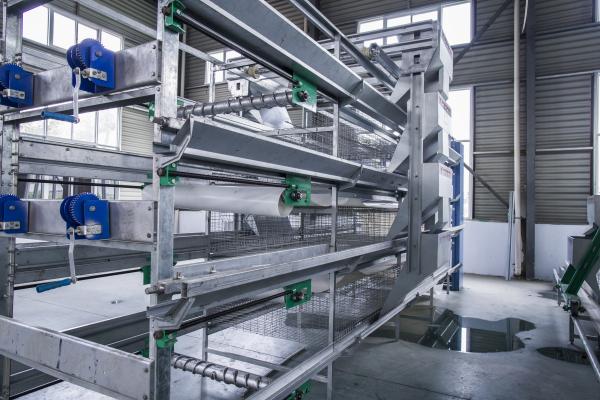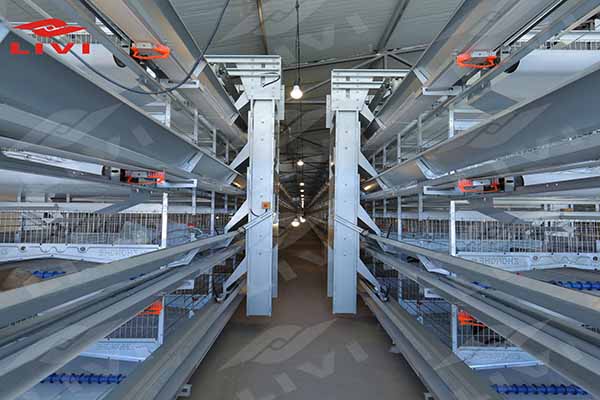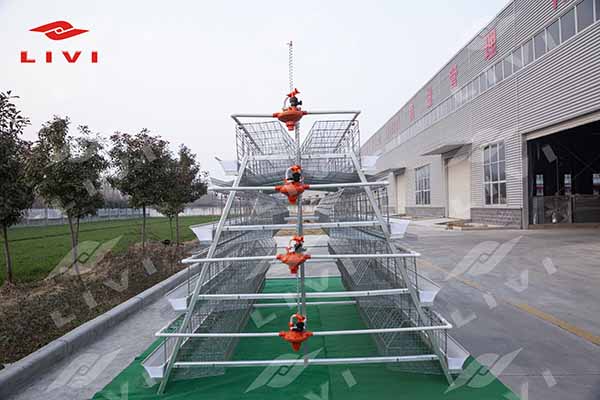Broiler Battery Farming is a kind of efficient space utilization mode, which is particularly important for the management of broilers. Correct feeding management can improve the growth rate of broilers, reduce the incidence of diseases, and ultimately improve the efficiency of breeding. How To Manage Broilers Using Battery Cage System? The following are the key management points of broiler battery farming:
1. Disinfection
Before the arrival of chicks, thorough cleaning and disinfection should be carried out for 5 days to avoid using corrosive disinfectants like caustic soda, which could damage equipment. Then, for every cubic meter of space, use 40ml of formaldehyde and fumigate with 20g of potassium permanganate. Afterward, seal doors and windows immediately upon exit and ventilate after 24 hours. Personnel entering and exiting the chicken house must strictly disinfect to avoid compromising disinfection effectiveness. Clean and disinfect feed troughs and waterers. After chicks arrive, sweep the floor clean daily to reduce dust and irritation to the respiratory system. Every other day thereafter, disinfect the entire area, alternating between several types of disinfectants. Avoid vaccination within 24 hours before or after disinfection.
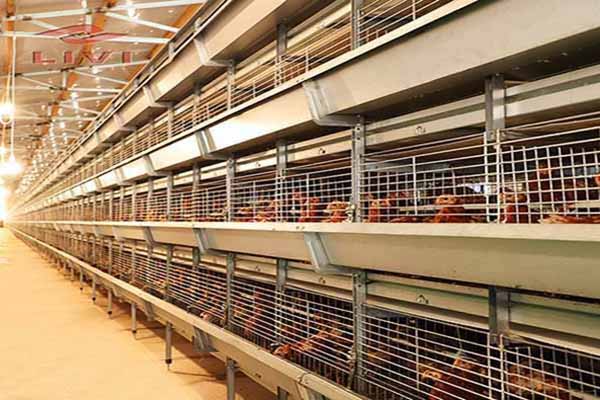
2. Temperature
There is a temperature difference between the upper, middle, and lower layers of the three-dimensional coop, which increases with lower outdoor temperatures. Managers should refer to the temperature in the middle layer. Generally, during chick rearing, they should be placed in the highest layer as it offers the highest temperature, thus conserving heat. On the first day of chick placement, the temperature should be maintained at 33-34°C, adjusting according to the chicks’ condition. As chicks grow older, reduce the temperature to 30°C by the first week, decreasing by 2°C each week thereafter. Due to the higher stocking density in three-dimensional farming, temperatures should be 1-2°C lower than flat farming to prevent heat stress and reduced feed intake.
3. Grouping
In three-dimensional farming, whole-batch chick rearing is common, but when chick density is too high, timely grouping is necessary to ensure uniform weight. The first grouping generally occurs at 12-16 days. Grouping too early may result in chicks being too small to prevent them from slipping through the gaps in the cages, leading to wasted space and energy. The second grouping occurs at 25-28 days. During grouping, the principle of “retain the weak, remove the strong” should be followed. Additionally, in summer, grouping may be done slightly earlier due to higher temperatures, while in winter, grouping may be delayed to reduce the temperature difference between upper and lower layers.
4. Ventilation
Proper ventilation is crucial for successful farming. It helps to eliminate harmful gases, control temperature, and reduce the incidence of diseases such as ascites, chronic respiratory diseases, and E. coli. Given the higher stocking density in three-dimensional farming, ventilation becomes even more critical. Within the first 24 hours of chick placement, ventilation may not be necessary due to the large overall space. However, as chicks age, increase ventilation gradually and adjust the position and size of air inlets accordingly. Ventilation should be adjusted throughout the day and according to weather conditions to ensure the air inside the chicken house is odorless, non-irritating, well-oxygenated, and comfortable for the chicks, enhancing their disease resistance and reducing disease incidence.

5. Equipment Usage
Advanced poultry farming equipment is prevalent in large and medium-sized poultry farms, but having advanced equipment doesn’t necessarily guarantee successful farming. The key lies in the organic combination of people and poultry farming equipment. Operators must not only be familiar with the principles of the equipment but also be vigilant. Due to inevitable errors between temperature controllers and actual temperatures inside the chicken house, operators must minimize these errors to ensure the chicken house’s temperature is optimal for the chicks’ growth. Additionally, operators must be proficient in using the equipment and familiar with the feeding procedures for chicks at different stages, promptly identifying and repairing equipment faults. Improper equipment usage or malfunctions can result in significant economic losses.
6. Water Supply
During the lengthy transportation process combined with high temperatures in the chick coop, chicks experience significant water loss. Therefore, ensure all chicks can access water within 2 hours of entering the coop. For weaker chicks, manual watering may be necessary to ensure they learn to drink water quickly. This can be done by gently holding the chick, fixing its head with the thumb and forefinger, and dipping its beak into the water. Additionally, adjust the height of nipple-type automatic waterers appropriately to prevent chicks from getting wet while drinking. Regularly flush waterers, and ensure uninterrupted access to water throughout the chick-rearing period. From the second day of chick rearing onwards, add medication to the water to prevent chick coccidiosis.
7. Feeding
After chicks enter the coop, they should be given water before feed to aid digestion. Feed should be placed in feeding trays 2-3 hours after water consumption. In three-dimensional farming, there should be approximately 25 chicks per small feeding trough. Avoid overfilling to prevent feed contamination and mold. Small feeding troughs can be used for about 7 days before switching to long troughs. Long troughs have a larger surface area, so when feed levels decrease, chicks’ feeding speed may slow down. Therefore, it’s essential to use a brush to push the feed closer to the chicks, making it easier for them to access and preventing feed spoilage. During the first 10 days, feed chicks 6-8 times a day.
For chicken farmers, quality broiler equipment is essential. The choice of broiler breeding equipment suppliers also needs to be carefully considered.
Livi Machinery is a leading brand in the field of broiler breeding and is known for its advanced poultry farming equipment. Our broiler battery cage system are well designed, robust and durable, providing a comfortable growing environment. Automated ventilation, drinking water and feeding equipment ensure efficient operation of the farming process. By choosing Livi machinery, you will get a reliable solution that improves farming efficiency, reduces costs and ensures the health of chickens. Let us work together to create a better future for the aquaculture industry!
Leave us a message for a free quote on broiler farming equipment.






